Civil Engineering Report: Analysis of Ground Improvement Techniques
VerifiedAdded on 2019/10/12
|20
|4682
|797
Report
AI Summary
This report provides a comprehensive overview of ground improvement techniques in civil engineering. It begins with an abstract highlighting the importance of these techniques in modern construction due to land scarcity. The report then delves into various methods, including mechanical stabilization (vibro flotation, heavy weight compaction, sand compaction piles, stone columns, blending, and blast densification), stabilization by pre-loading, and stabilization by sand drain methods. Furthermore, it explores physical and chemical modification techniques such as grouting, electro-osmosis, soil cement, heating, and freezing. The report also discusses different types of soil and their characteristics. A table of findings correlates soil types with suitable techniques and associated costs. In conclusion, the report emphasizes the significance of ground improvement in enhancing soil strength and minimizing settlement, offering valuable insights for civil engineers. The report covers modern and essential ground improvement methods, discussing their applications and benefits in construction projects, and is contributed by a student to be published on the website Desklib, which offers AI-based study tools for students.
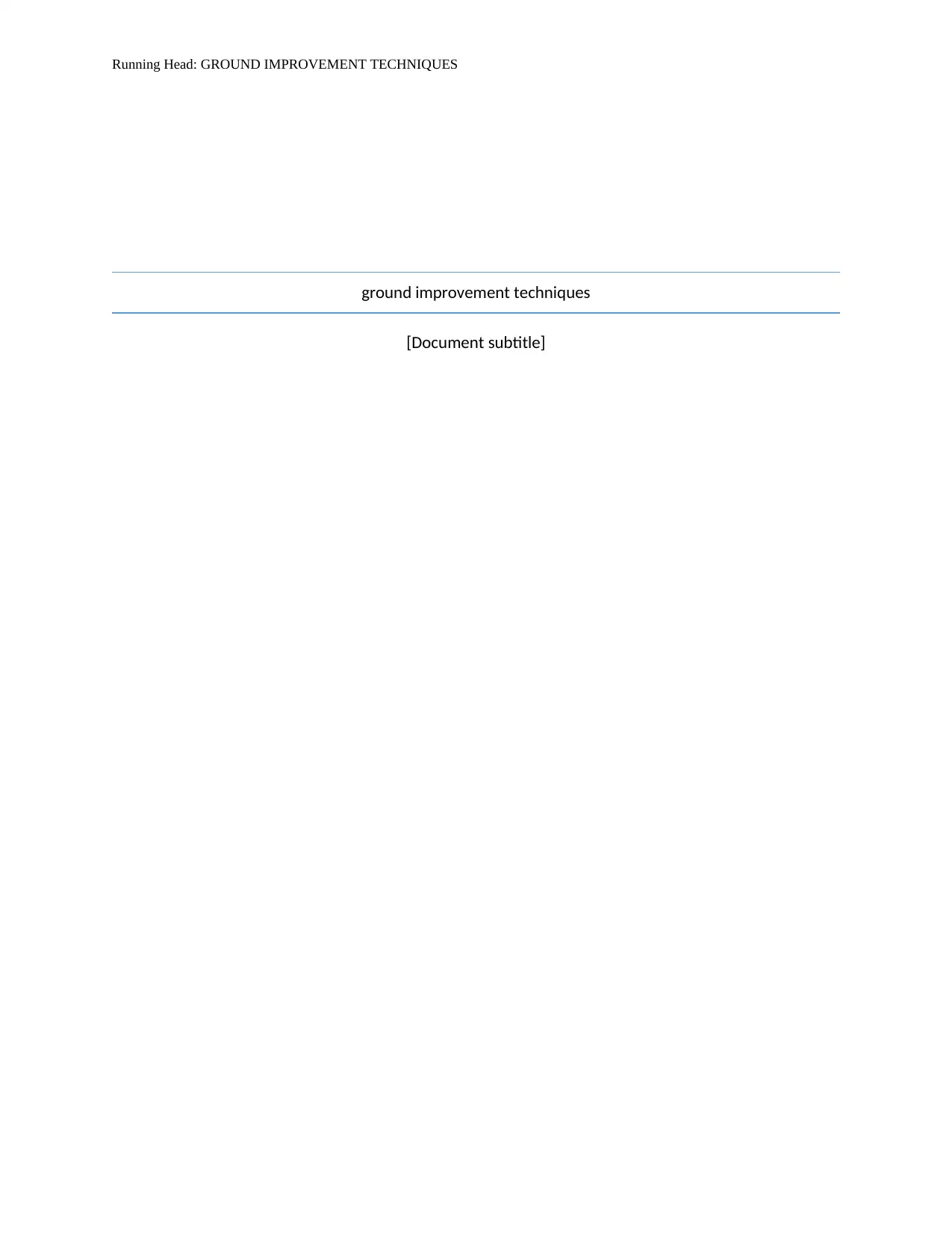
Running Head: GROUND IMPROVEMENT TECHNIQUES
ground improvement techniques
[Document subtitle]
ground improvement techniques
[Document subtitle]
Paraphrase This Document
Need a fresh take? Get an instant paraphrase of this document with our AI Paraphraser
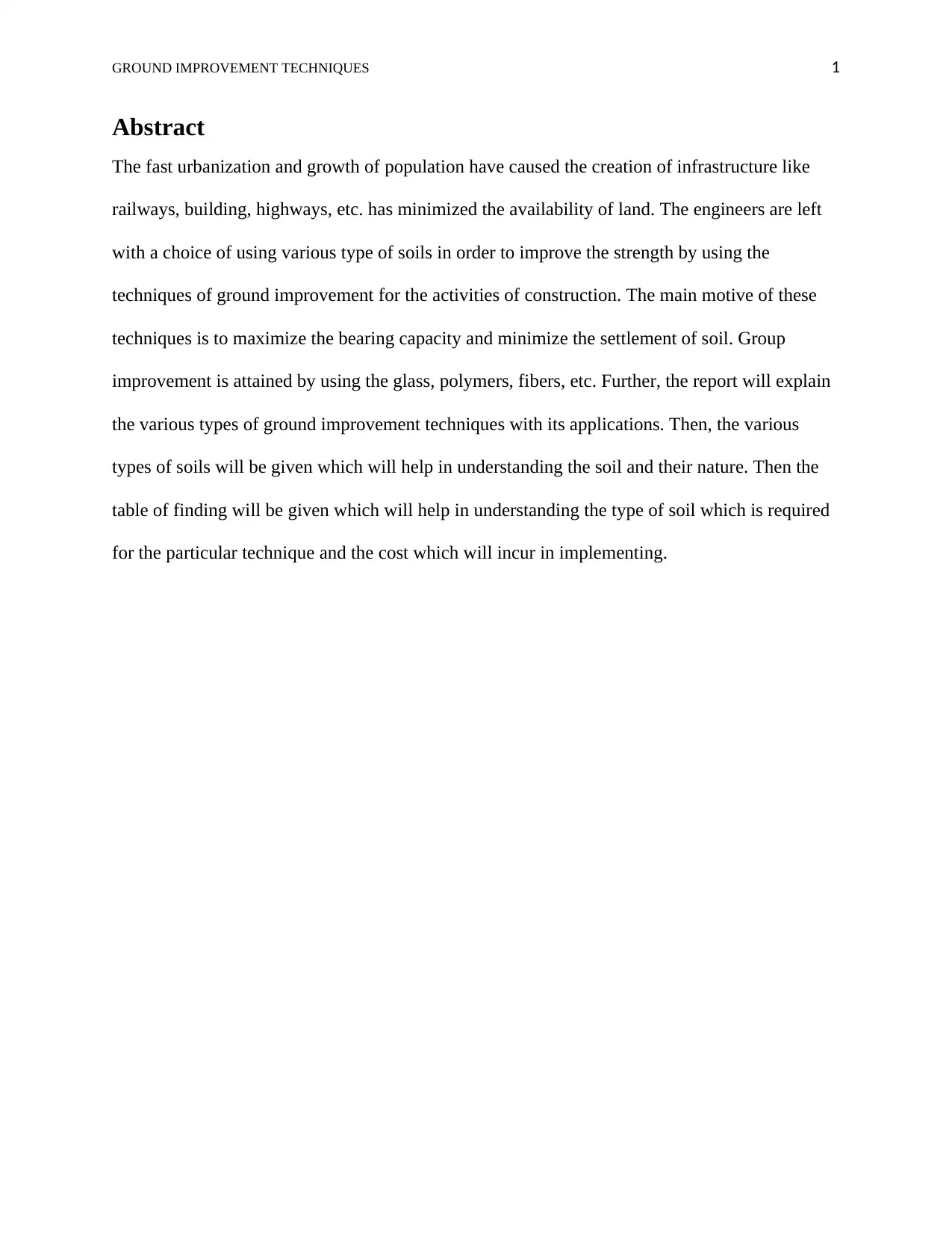
GROUND IMPROVEMENT TECHNIQUES 1
Abstract
The fast urbanization and growth of population have caused the creation of infrastructure like
railways, building, highways, etc. has minimized the availability of land. The engineers are left
with a choice of using various type of soils in order to improve the strength by using the
techniques of ground improvement for the activities of construction. The main motive of these
techniques is to maximize the bearing capacity and minimize the settlement of soil. Group
improvement is attained by using the glass, polymers, fibers, etc. Further, the report will explain
the various types of ground improvement techniques with its applications. Then, the various
types of soils will be given which will help in understanding the soil and their nature. Then the
table of finding will be given which will help in understanding the type of soil which is required
for the particular technique and the cost which will incur in implementing.
Abstract
The fast urbanization and growth of population have caused the creation of infrastructure like
railways, building, highways, etc. has minimized the availability of land. The engineers are left
with a choice of using various type of soils in order to improve the strength by using the
techniques of ground improvement for the activities of construction. The main motive of these
techniques is to maximize the bearing capacity and minimize the settlement of soil. Group
improvement is attained by using the glass, polymers, fibers, etc. Further, the report will explain
the various types of ground improvement techniques with its applications. Then, the various
types of soils will be given which will help in understanding the soil and their nature. Then the
table of finding will be given which will help in understanding the type of soil which is required
for the particular technique and the cost which will incur in implementing.
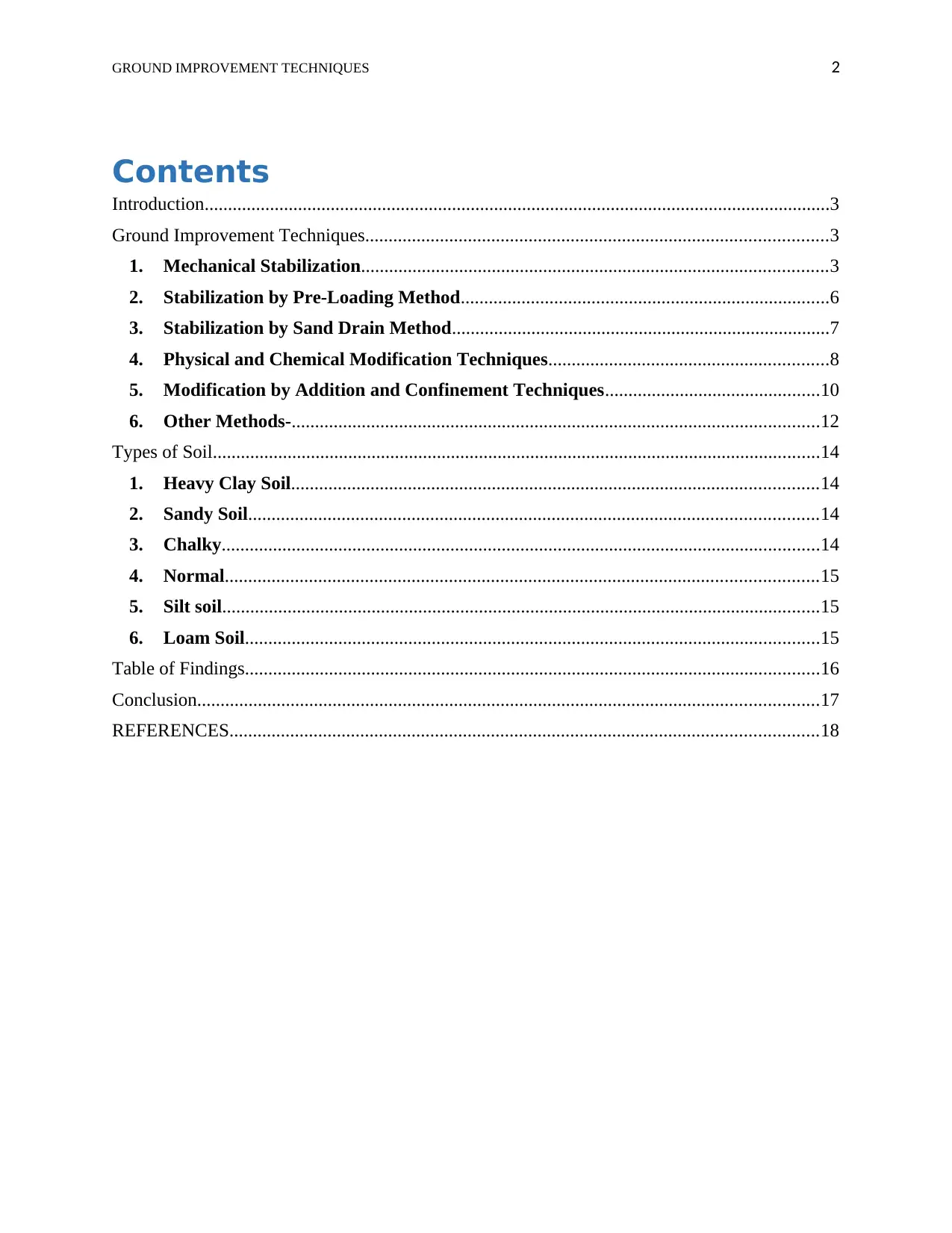
GROUND IMPROVEMENT TECHNIQUES 2
Contents
Introduction......................................................................................................................................3
Ground Improvement Techniques...................................................................................................3
1. Mechanical Stabilization....................................................................................................3
2. Stabilization by Pre-Loading Method...............................................................................6
3. Stabilization by Sand Drain Method.................................................................................7
4. Physical and Chemical Modification Techniques............................................................8
5. Modification by Addition and Confinement Techniques..............................................10
6. Other Methods-.................................................................................................................12
Types of Soil..................................................................................................................................14
1. Heavy Clay Soil.................................................................................................................14
2. Sandy Soil..........................................................................................................................14
3. Chalky................................................................................................................................14
4. Normal...............................................................................................................................15
5. Silt soil................................................................................................................................15
6. Loam Soil...........................................................................................................................15
Table of Findings...........................................................................................................................16
Conclusion.....................................................................................................................................17
REFERENCES..............................................................................................................................18
Contents
Introduction......................................................................................................................................3
Ground Improvement Techniques...................................................................................................3
1. Mechanical Stabilization....................................................................................................3
2. Stabilization by Pre-Loading Method...............................................................................6
3. Stabilization by Sand Drain Method.................................................................................7
4. Physical and Chemical Modification Techniques............................................................8
5. Modification by Addition and Confinement Techniques..............................................10
6. Other Methods-.................................................................................................................12
Types of Soil..................................................................................................................................14
1. Heavy Clay Soil.................................................................................................................14
2. Sandy Soil..........................................................................................................................14
3. Chalky................................................................................................................................14
4. Normal...............................................................................................................................15
5. Silt soil................................................................................................................................15
6. Loam Soil...........................................................................................................................15
Table of Findings...........................................................................................................................16
Conclusion.....................................................................................................................................17
REFERENCES..............................................................................................................................18
⊘ This is a preview!⊘
Do you want full access?
Subscribe today to unlock all pages.

Trusted by 1+ million students worldwide

GROUND IMPROVEMENT TECHNIQUES 3
Introduction
Nowadays, the industrial, cultural and economic growth of a country relies on the system of its
transportation. The railways and highways help in providing maximum services to the customers.
It has been observed that there is a scarcity of land because of the infrastructure’s development
like buildings. As a result, the engineers are restricted to use weak and inferior soil for the
process of construction. The various techniques of ground improvement are becoming very
important for the projects of construction. This technique helps in increasing the soil’s strength
and helps in reducing compressibility (Bitir et al, 2014). The soils which are expansive and
collapsible are difficult to use because of their behavior of shrinkage and swelling action. The
techniques of ground improvement help the construction easy on soft and organic soils, sanitary
landfills, deposits of karst, etc. Further, the report contains the modern and important techniques
of ground improvement with their applications.
Ground Improvement Techniques
The various techniques of ground improvement which are used nowadays are as follows (Patra,
N. R., 2014):
1. Mechanical Stabilization
This technique helps in increasing the density of soil by using the mechanical force in the shape
of vibratory rollers, static, plate vibrators, etc. in order to gain the compaction. Compaction can
be done properly if the material of soil fill is graded properly. Further, it will be categorized by a
coefficient of high uniformity Cu>15, a coefficient of curvature Cc within the range of 1 and 3
can be easily compacted to the high density with the help of tampers, rollers, and other tools. The
Introduction
Nowadays, the industrial, cultural and economic growth of a country relies on the system of its
transportation. The railways and highways help in providing maximum services to the customers.
It has been observed that there is a scarcity of land because of the infrastructure’s development
like buildings. As a result, the engineers are restricted to use weak and inferior soil for the
process of construction. The various techniques of ground improvement are becoming very
important for the projects of construction. This technique helps in increasing the soil’s strength
and helps in reducing compressibility (Bitir et al, 2014). The soils which are expansive and
collapsible are difficult to use because of their behavior of shrinkage and swelling action. The
techniques of ground improvement help the construction easy on soft and organic soils, sanitary
landfills, deposits of karst, etc. Further, the report contains the modern and important techniques
of ground improvement with their applications.
Ground Improvement Techniques
The various techniques of ground improvement which are used nowadays are as follows (Patra,
N. R., 2014):
1. Mechanical Stabilization
This technique helps in increasing the density of soil by using the mechanical force in the shape
of vibratory rollers, static, plate vibrators, etc. in order to gain the compaction. Compaction can
be done properly if the material of soil fill is graded properly. Further, it will be categorized by a
coefficient of high uniformity Cu>15, a coefficient of curvature Cc within the range of 1 and 3
can be easily compacted to the high density with the help of tampers, rollers, and other tools. The
Paraphrase This Document
Need a fresh take? Get an instant paraphrase of this document with our AI Paraphraser
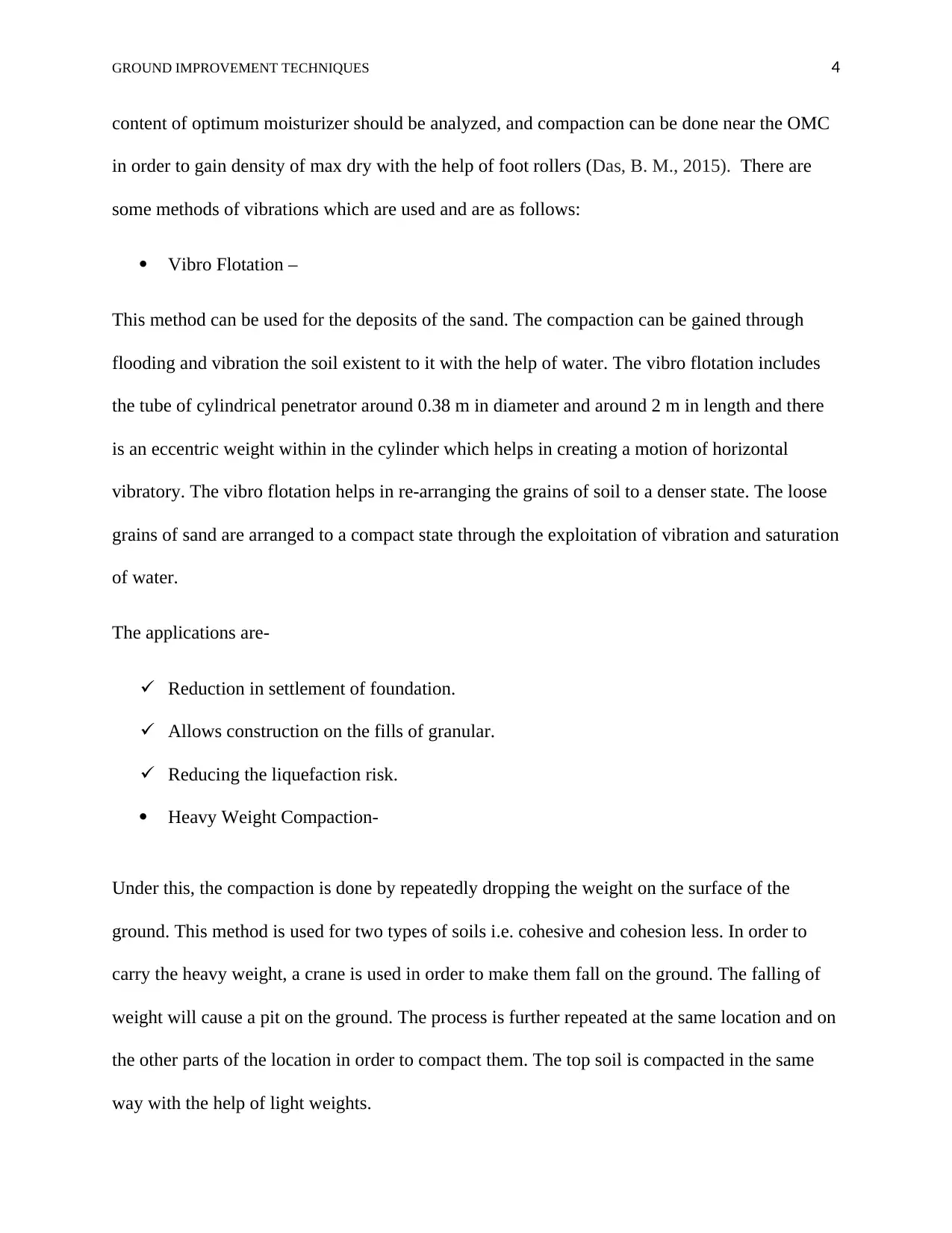
GROUND IMPROVEMENT TECHNIQUES 4
content of optimum moisturizer should be analyzed, and compaction can be done near the OMC
in order to gain density of max dry with the help of foot rollers (Das, B. M., 2015). There are
some methods of vibrations which are used and are as follows:
Vibro Flotation –
This method can be used for the deposits of the sand. The compaction can be gained through
flooding and vibration the soil existent to it with the help of water. The vibro flotation includes
the tube of cylindrical penetrator around 0.38 m in diameter and around 2 m in length and there
is an eccentric weight within in the cylinder which helps in creating a motion of horizontal
vibratory. The vibro flotation helps in re-arranging the grains of soil to a denser state. The loose
grains of sand are arranged to a compact state through the exploitation of vibration and saturation
of water.
The applications are-
Reduction in settlement of foundation.
Allows construction on the fills of granular.
Reducing the liquefaction risk.
Heavy Weight Compaction-
Under this, the compaction is done by repeatedly dropping the weight on the surface of the
ground. This method is used for two types of soils i.e. cohesive and cohesion less. In order to
carry the heavy weight, a crane is used in order to make them fall on the ground. The falling of
weight will cause a pit on the ground. The process is further repeated at the same location and on
the other parts of the location in order to compact them. The top soil is compacted in the same
way with the help of light weights.
content of optimum moisturizer should be analyzed, and compaction can be done near the OMC
in order to gain density of max dry with the help of foot rollers (Das, B. M., 2015). There are
some methods of vibrations which are used and are as follows:
Vibro Flotation –
This method can be used for the deposits of the sand. The compaction can be gained through
flooding and vibration the soil existent to it with the help of water. The vibro flotation includes
the tube of cylindrical penetrator around 0.38 m in diameter and around 2 m in length and there
is an eccentric weight within in the cylinder which helps in creating a motion of horizontal
vibratory. The vibro flotation helps in re-arranging the grains of soil to a denser state. The loose
grains of sand are arranged to a compact state through the exploitation of vibration and saturation
of water.
The applications are-
Reduction in settlement of foundation.
Allows construction on the fills of granular.
Reducing the liquefaction risk.
Heavy Weight Compaction-
Under this, the compaction is done by repeatedly dropping the weight on the surface of the
ground. This method is used for two types of soils i.e. cohesive and cohesion less. In order to
carry the heavy weight, a crane is used in order to make them fall on the ground. The falling of
weight will cause a pit on the ground. The process is further repeated at the same location and on
the other parts of the location in order to compact them. The top soil is compacted in the same
way with the help of light weights.
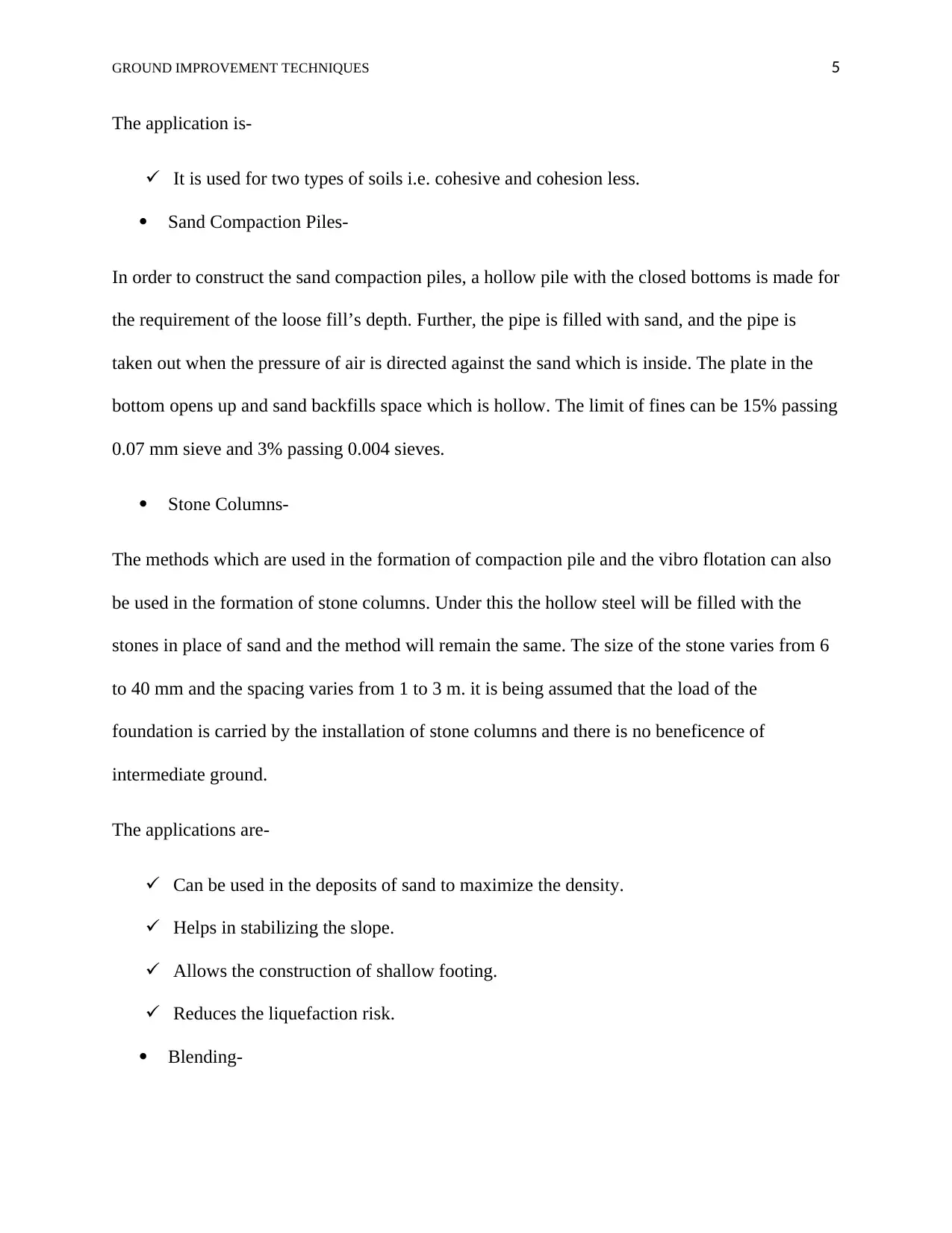
GROUND IMPROVEMENT TECHNIQUES 5
The application is-
It is used for two types of soils i.e. cohesive and cohesion less.
Sand Compaction Piles-
In order to construct the sand compaction piles, a hollow pile with the closed bottoms is made for
the requirement of the loose fill’s depth. Further, the pipe is filled with sand, and the pipe is
taken out when the pressure of air is directed against the sand which is inside. The plate in the
bottom opens up and sand backfills space which is hollow. The limit of fines can be 15% passing
0.07 mm sieve and 3% passing 0.004 sieves.
Stone Columns-
The methods which are used in the formation of compaction pile and the vibro flotation can also
be used in the formation of stone columns. Under this the hollow steel will be filled with the
stones in place of sand and the method will remain the same. The size of the stone varies from 6
to 40 mm and the spacing varies from 1 to 3 m. it is being assumed that the load of the
foundation is carried by the installation of stone columns and there is no beneficence of
intermediate ground.
The applications are-
Can be used in the deposits of sand to maximize the density.
Helps in stabilizing the slope.
Allows the construction of shallow footing.
Reduces the liquefaction risk.
Blending-
The application is-
It is used for two types of soils i.e. cohesive and cohesion less.
Sand Compaction Piles-
In order to construct the sand compaction piles, a hollow pile with the closed bottoms is made for
the requirement of the loose fill’s depth. Further, the pipe is filled with sand, and the pipe is
taken out when the pressure of air is directed against the sand which is inside. The plate in the
bottom opens up and sand backfills space which is hollow. The limit of fines can be 15% passing
0.07 mm sieve and 3% passing 0.004 sieves.
Stone Columns-
The methods which are used in the formation of compaction pile and the vibro flotation can also
be used in the formation of stone columns. Under this the hollow steel will be filled with the
stones in place of sand and the method will remain the same. The size of the stone varies from 6
to 40 mm and the spacing varies from 1 to 3 m. it is being assumed that the load of the
foundation is carried by the installation of stone columns and there is no beneficence of
intermediate ground.
The applications are-
Can be used in the deposits of sand to maximize the density.
Helps in stabilizing the slope.
Allows the construction of shallow footing.
Reduces the liquefaction risk.
Blending-
⊘ This is a preview!⊘
Do you want full access?
Subscribe today to unlock all pages.

Trusted by 1+ million students worldwide
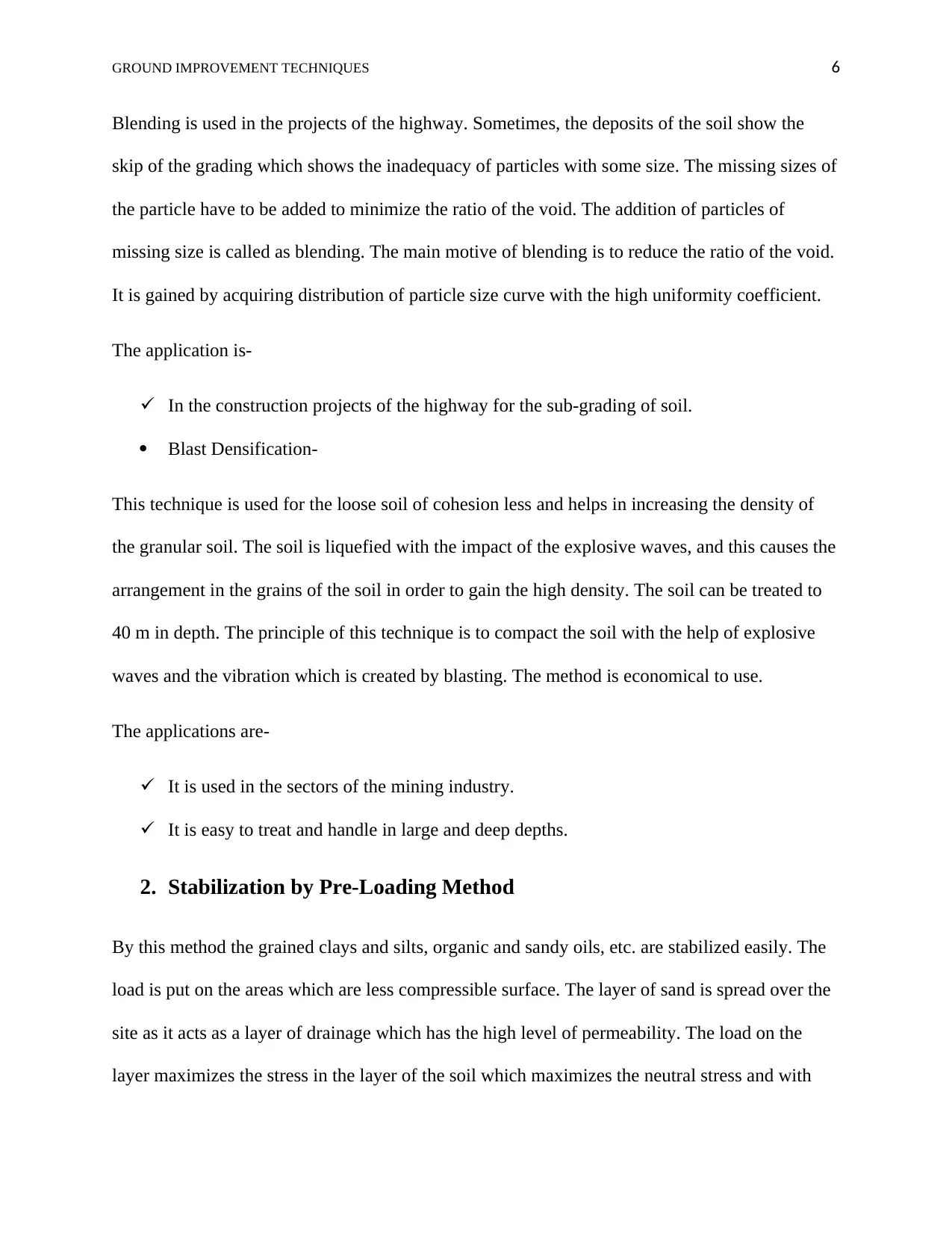
GROUND IMPROVEMENT TECHNIQUES 6
Blending is used in the projects of the highway. Sometimes, the deposits of the soil show the
skip of the grading which shows the inadequacy of particles with some size. The missing sizes of
the particle have to be added to minimize the ratio of the void. The addition of particles of
missing size is called as blending. The main motive of blending is to reduce the ratio of the void.
It is gained by acquiring distribution of particle size curve with the high uniformity coefficient.
The application is-
In the construction projects of the highway for the sub-grading of soil.
Blast Densification-
This technique is used for the loose soil of cohesion less and helps in increasing the density of
the granular soil. The soil is liquefied with the impact of the explosive waves, and this causes the
arrangement in the grains of the soil in order to gain the high density. The soil can be treated to
40 m in depth. The principle of this technique is to compact the soil with the help of explosive
waves and the vibration which is created by blasting. The method is economical to use.
The applications are-
It is used in the sectors of the mining industry.
It is easy to treat and handle in large and deep depths.
2. Stabilization by Pre-Loading Method
By this method the grained clays and silts, organic and sandy oils, etc. are stabilized easily. The
load is put on the areas which are less compressible surface. The layer of sand is spread over the
site as it acts as a layer of drainage which has the high level of permeability. The load on the
layer maximizes the stress in the layer of the soil which maximizes the neutral stress and with
Blending is used in the projects of the highway. Sometimes, the deposits of the soil show the
skip of the grading which shows the inadequacy of particles with some size. The missing sizes of
the particle have to be added to minimize the ratio of the void. The addition of particles of
missing size is called as blending. The main motive of blending is to reduce the ratio of the void.
It is gained by acquiring distribution of particle size curve with the high uniformity coefficient.
The application is-
In the construction projects of the highway for the sub-grading of soil.
Blast Densification-
This technique is used for the loose soil of cohesion less and helps in increasing the density of
the granular soil. The soil is liquefied with the impact of the explosive waves, and this causes the
arrangement in the grains of the soil in order to gain the high density. The soil can be treated to
40 m in depth. The principle of this technique is to compact the soil with the help of explosive
waves and the vibration which is created by blasting. The method is economical to use.
The applications are-
It is used in the sectors of the mining industry.
It is easy to treat and handle in large and deep depths.
2. Stabilization by Pre-Loading Method
By this method the grained clays and silts, organic and sandy oils, etc. are stabilized easily. The
load is put on the areas which are less compressible surface. The layer of sand is spread over the
site as it acts as a layer of drainage which has the high level of permeability. The load on the
layer maximizes the stress in the layer of the soil which maximizes the neutral stress and with
Paraphrase This Document
Need a fresh take? Get an instant paraphrase of this document with our AI Paraphraser
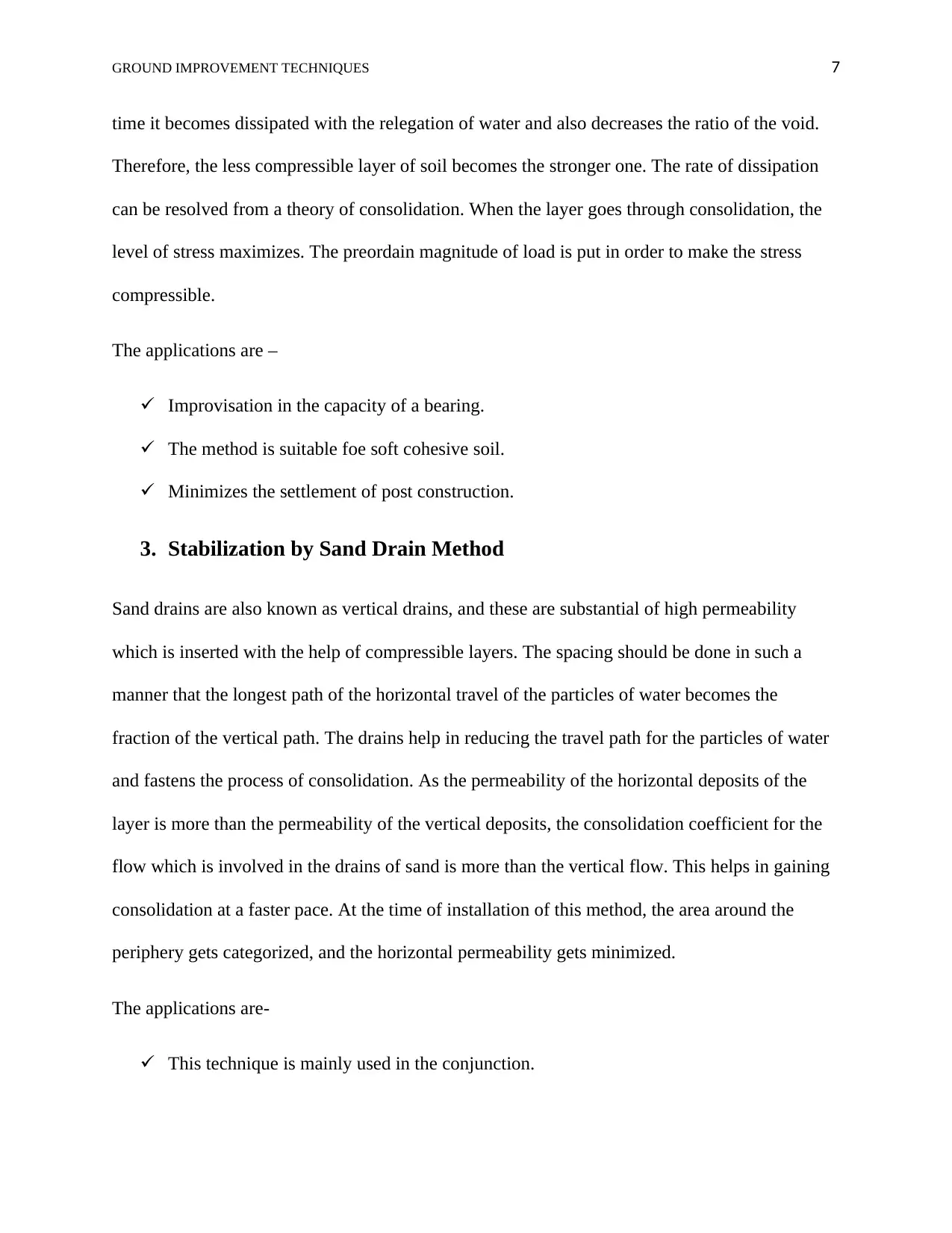
GROUND IMPROVEMENT TECHNIQUES 7
time it becomes dissipated with the relegation of water and also decreases the ratio of the void.
Therefore, the less compressible layer of soil becomes the stronger one. The rate of dissipation
can be resolved from a theory of consolidation. When the layer goes through consolidation, the
level of stress maximizes. The preordain magnitude of load is put in order to make the stress
compressible.
The applications are –
Improvisation in the capacity of a bearing.
The method is suitable foe soft cohesive soil.
Minimizes the settlement of post construction.
3. Stabilization by Sand Drain Method
Sand drains are also known as vertical drains, and these are substantial of high permeability
which is inserted with the help of compressible layers. The spacing should be done in such a
manner that the longest path of the horizontal travel of the particles of water becomes the
fraction of the vertical path. The drains help in reducing the travel path for the particles of water
and fastens the process of consolidation. As the permeability of the horizontal deposits of the
layer is more than the permeability of the vertical deposits, the consolidation coefficient for the
flow which is involved in the drains of sand is more than the vertical flow. This helps in gaining
consolidation at a faster pace. At the time of installation of this method, the area around the
periphery gets categorized, and the horizontal permeability gets minimized.
The applications are-
This technique is mainly used in the conjunction.
time it becomes dissipated with the relegation of water and also decreases the ratio of the void.
Therefore, the less compressible layer of soil becomes the stronger one. The rate of dissipation
can be resolved from a theory of consolidation. When the layer goes through consolidation, the
level of stress maximizes. The preordain magnitude of load is put in order to make the stress
compressible.
The applications are –
Improvisation in the capacity of a bearing.
The method is suitable foe soft cohesive soil.
Minimizes the settlement of post construction.
3. Stabilization by Sand Drain Method
Sand drains are also known as vertical drains, and these are substantial of high permeability
which is inserted with the help of compressible layers. The spacing should be done in such a
manner that the longest path of the horizontal travel of the particles of water becomes the
fraction of the vertical path. The drains help in reducing the travel path for the particles of water
and fastens the process of consolidation. As the permeability of the horizontal deposits of the
layer is more than the permeability of the vertical deposits, the consolidation coefficient for the
flow which is involved in the drains of sand is more than the vertical flow. This helps in gaining
consolidation at a faster pace. At the time of installation of this method, the area around the
periphery gets categorized, and the horizontal permeability gets minimized.
The applications are-
This technique is mainly used in the conjunction.
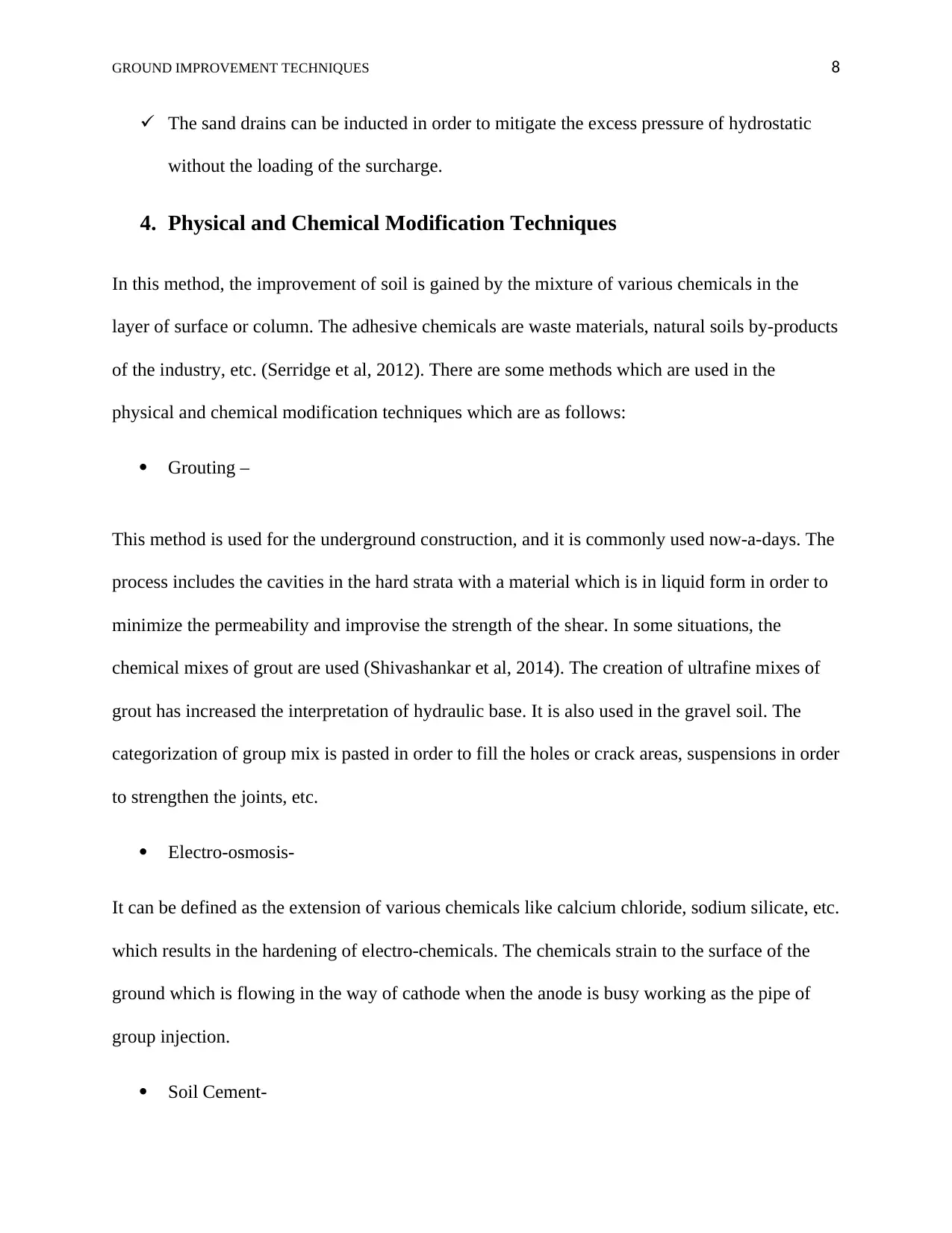
GROUND IMPROVEMENT TECHNIQUES 8
The sand drains can be inducted in order to mitigate the excess pressure of hydrostatic
without the loading of the surcharge.
4. Physical and Chemical Modification Techniques
In this method, the improvement of soil is gained by the mixture of various chemicals in the
layer of surface or column. The adhesive chemicals are waste materials, natural soils by-products
of the industry, etc. (Serridge et al, 2012). There are some methods which are used in the
physical and chemical modification techniques which are as follows:
Grouting –
This method is used for the underground construction, and it is commonly used now-a-days. The
process includes the cavities in the hard strata with a material which is in liquid form in order to
minimize the permeability and improvise the strength of the shear. In some situations, the
chemical mixes of grout are used (Shivashankar et al, 2014). The creation of ultrafine mixes of
grout has increased the interpretation of hydraulic base. It is also used in the gravel soil. The
categorization of group mix is pasted in order to fill the holes or crack areas, suspensions in order
to strengthen the joints, etc.
Electro-osmosis-
It can be defined as the extension of various chemicals like calcium chloride, sodium silicate, etc.
which results in the hardening of electro-chemicals. The chemicals strain to the surface of the
ground which is flowing in the way of cathode when the anode is busy working as the pipe of
group injection.
Soil Cement-
The sand drains can be inducted in order to mitigate the excess pressure of hydrostatic
without the loading of the surcharge.
4. Physical and Chemical Modification Techniques
In this method, the improvement of soil is gained by the mixture of various chemicals in the
layer of surface or column. The adhesive chemicals are waste materials, natural soils by-products
of the industry, etc. (Serridge et al, 2012). There are some methods which are used in the
physical and chemical modification techniques which are as follows:
Grouting –
This method is used for the underground construction, and it is commonly used now-a-days. The
process includes the cavities in the hard strata with a material which is in liquid form in order to
minimize the permeability and improvise the strength of the shear. In some situations, the
chemical mixes of grout are used (Shivashankar et al, 2014). The creation of ultrafine mixes of
grout has increased the interpretation of hydraulic base. It is also used in the gravel soil. The
categorization of group mix is pasted in order to fill the holes or crack areas, suspensions in order
to strengthen the joints, etc.
Electro-osmosis-
It can be defined as the extension of various chemicals like calcium chloride, sodium silicate, etc.
which results in the hardening of electro-chemicals. The chemicals strain to the surface of the
ground which is flowing in the way of cathode when the anode is busy working as the pipe of
group injection.
Soil Cement-
⊘ This is a preview!⊘
Do you want full access?
Subscribe today to unlock all pages.

Trusted by 1+ million students worldwide
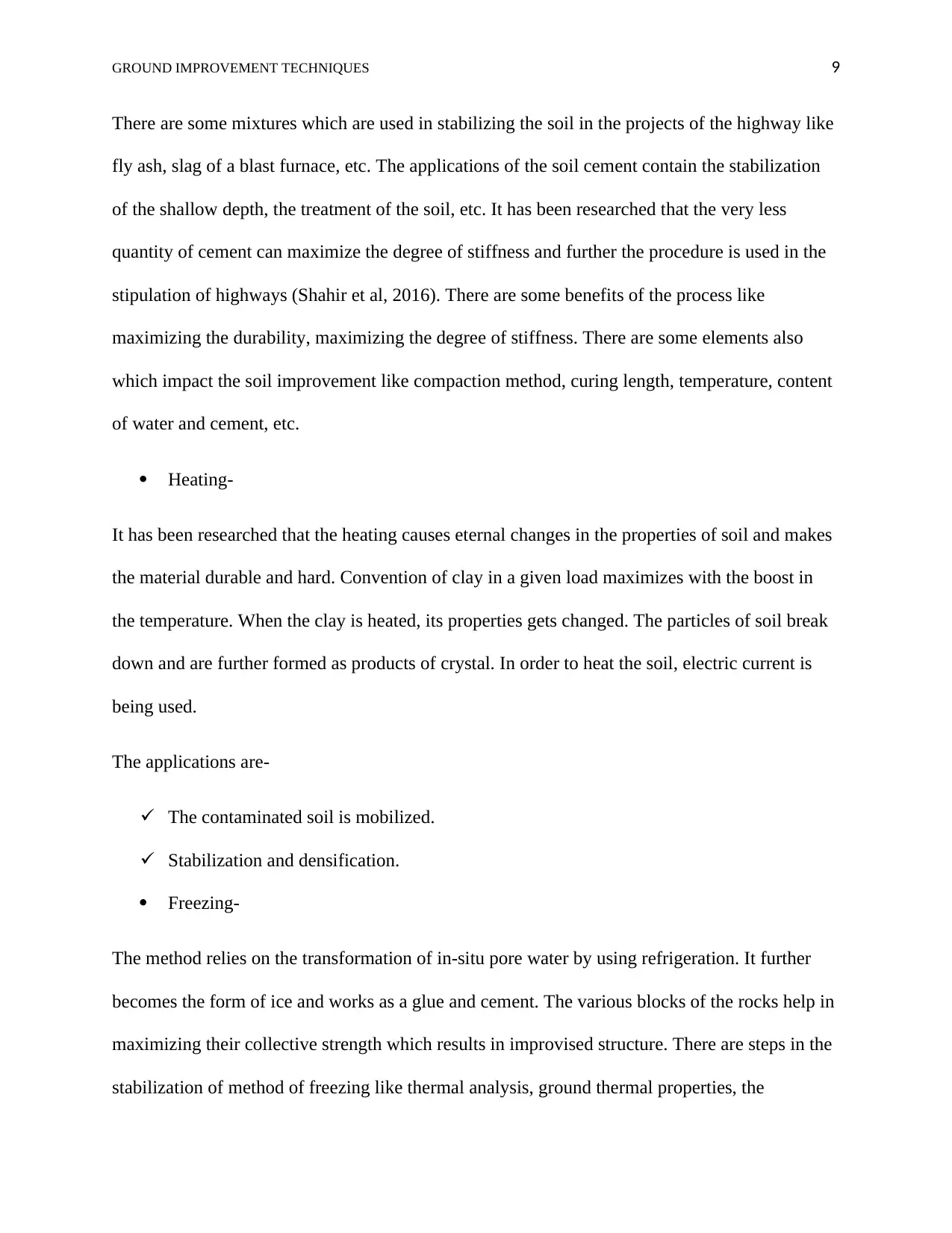
GROUND IMPROVEMENT TECHNIQUES 9
There are some mixtures which are used in stabilizing the soil in the projects of the highway like
fly ash, slag of a blast furnace, etc. The applications of the soil cement contain the stabilization
of the shallow depth, the treatment of the soil, etc. It has been researched that the very less
quantity of cement can maximize the degree of stiffness and further the procedure is used in the
stipulation of highways (Shahir et al, 2016). There are some benefits of the process like
maximizing the durability, maximizing the degree of stiffness. There are some elements also
which impact the soil improvement like compaction method, curing length, temperature, content
of water and cement, etc.
Heating-
It has been researched that the heating causes eternal changes in the properties of soil and makes
the material durable and hard. Convention of clay in a given load maximizes with the boost in
the temperature. When the clay is heated, its properties gets changed. The particles of soil break
down and are further formed as products of crystal. In order to heat the soil, electric current is
being used.
The applications are-
The contaminated soil is mobilized.
Stabilization and densification.
Freezing-
The method relies on the transformation of in-situ pore water by using refrigeration. It further
becomes the form of ice and works as a glue and cement. The various blocks of the rocks help in
maximizing their collective strength which results in improvised structure. There are steps in the
stabilization of method of freezing like thermal analysis, ground thermal properties, the
There are some mixtures which are used in stabilizing the soil in the projects of the highway like
fly ash, slag of a blast furnace, etc. The applications of the soil cement contain the stabilization
of the shallow depth, the treatment of the soil, etc. It has been researched that the very less
quantity of cement can maximize the degree of stiffness and further the procedure is used in the
stipulation of highways (Shahir et al, 2016). There are some benefits of the process like
maximizing the durability, maximizing the degree of stiffness. There are some elements also
which impact the soil improvement like compaction method, curing length, temperature, content
of water and cement, etc.
Heating-
It has been researched that the heating causes eternal changes in the properties of soil and makes
the material durable and hard. Convention of clay in a given load maximizes with the boost in
the temperature. When the clay is heated, its properties gets changed. The particles of soil break
down and are further formed as products of crystal. In order to heat the soil, electric current is
being used.
The applications are-
The contaminated soil is mobilized.
Stabilization and densification.
Freezing-
The method relies on the transformation of in-situ pore water by using refrigeration. It further
becomes the form of ice and works as a glue and cement. The various blocks of the rocks help in
maximizing their collective strength which results in improvised structure. There are steps in the
stabilization of method of freezing like thermal analysis, ground thermal properties, the
Paraphrase This Document
Need a fresh take? Get an instant paraphrase of this document with our AI Paraphraser
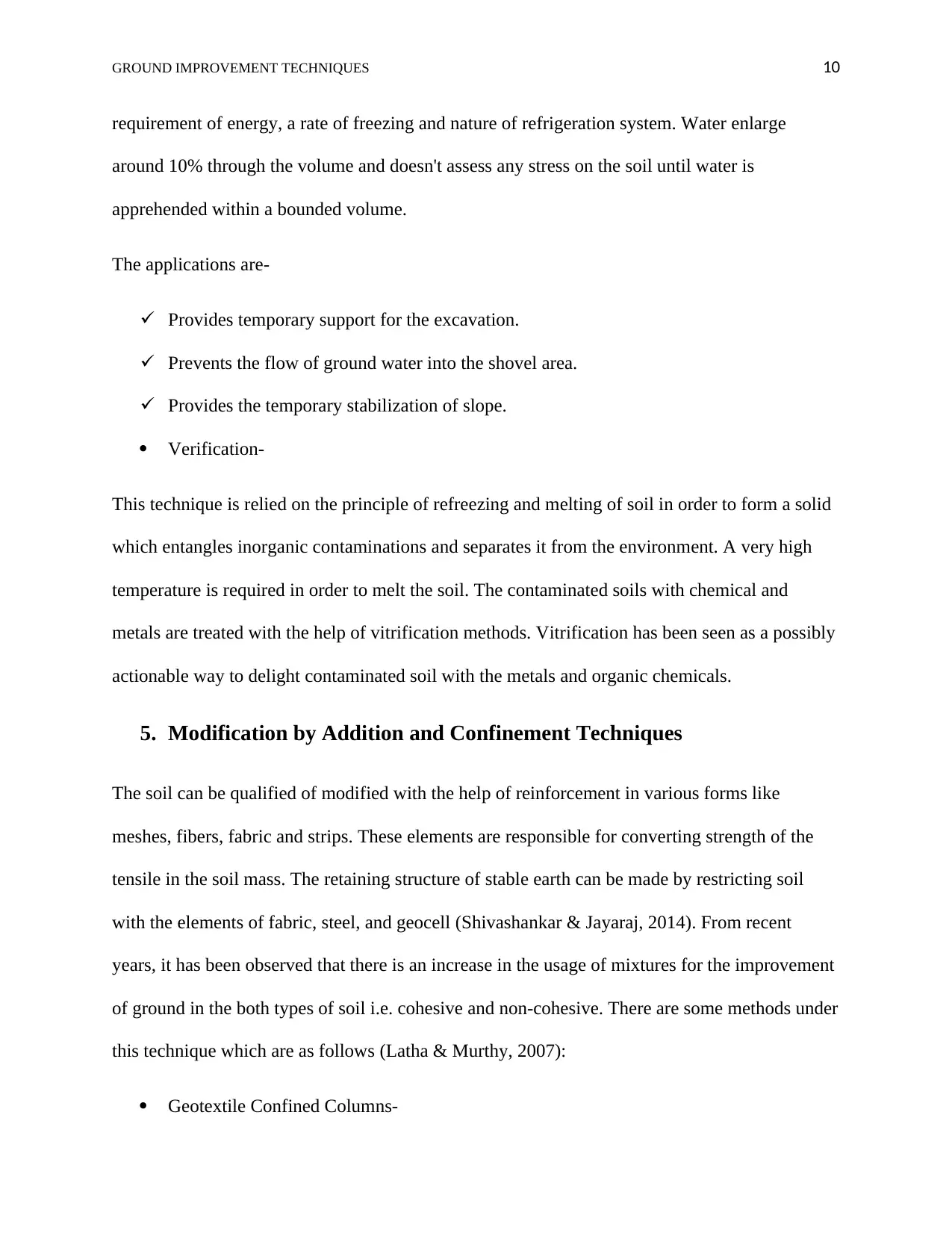
GROUND IMPROVEMENT TECHNIQUES 10
requirement of energy, a rate of freezing and nature of refrigeration system. Water enlarge
around 10% through the volume and doesn't assess any stress on the soil until water is
apprehended within a bounded volume.
The applications are-
Provides temporary support for the excavation.
Prevents the flow of ground water into the shovel area.
Provides the temporary stabilization of slope.
Verification-
This technique is relied on the principle of refreezing and melting of soil in order to form a solid
which entangles inorganic contaminations and separates it from the environment. A very high
temperature is required in order to melt the soil. The contaminated soils with chemical and
metals are treated with the help of vitrification methods. Vitrification has been seen as a possibly
actionable way to delight contaminated soil with the metals and organic chemicals.
5. Modification by Addition and Confinement Techniques
The soil can be qualified of modified with the help of reinforcement in various forms like
meshes, fibers, fabric and strips. These elements are responsible for converting strength of the
tensile in the soil mass. The retaining structure of stable earth can be made by restricting soil
with the elements of fabric, steel, and geocell (Shivashankar & Jayaraj, 2014). From recent
years, it has been observed that there is an increase in the usage of mixtures for the improvement
of ground in the both types of soil i.e. cohesive and non-cohesive. There are some methods under
this technique which are as follows (Latha & Murthy, 2007):
Geotextile Confined Columns-
requirement of energy, a rate of freezing and nature of refrigeration system. Water enlarge
around 10% through the volume and doesn't assess any stress on the soil until water is
apprehended within a bounded volume.
The applications are-
Provides temporary support for the excavation.
Prevents the flow of ground water into the shovel area.
Provides the temporary stabilization of slope.
Verification-
This technique is relied on the principle of refreezing and melting of soil in order to form a solid
which entangles inorganic contaminations and separates it from the environment. A very high
temperature is required in order to melt the soil. The contaminated soils with chemical and
metals are treated with the help of vitrification methods. Vitrification has been seen as a possibly
actionable way to delight contaminated soil with the metals and organic chemicals.
5. Modification by Addition and Confinement Techniques
The soil can be qualified of modified with the help of reinforcement in various forms like
meshes, fibers, fabric and strips. These elements are responsible for converting strength of the
tensile in the soil mass. The retaining structure of stable earth can be made by restricting soil
with the elements of fabric, steel, and geocell (Shivashankar & Jayaraj, 2014). From recent
years, it has been observed that there is an increase in the usage of mixtures for the improvement
of ground in the both types of soil i.e. cohesive and non-cohesive. There are some methods under
this technique which are as follows (Latha & Murthy, 2007):
Geotextile Confined Columns-
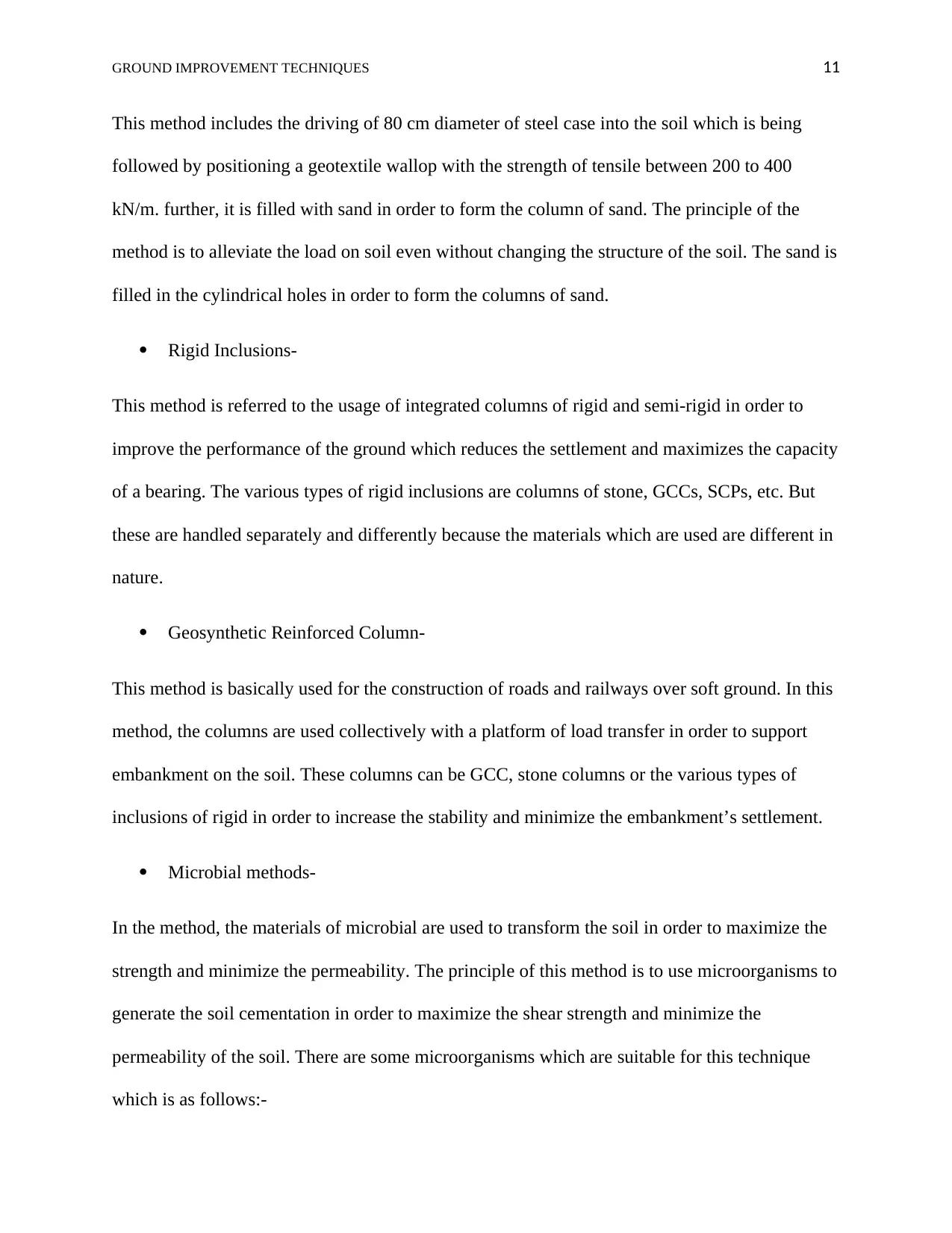
GROUND IMPROVEMENT TECHNIQUES 11
This method includes the driving of 80 cm diameter of steel case into the soil which is being
followed by positioning a geotextile wallop with the strength of tensile between 200 to 400
kN/m. further, it is filled with sand in order to form the column of sand. The principle of the
method is to alleviate the load on soil even without changing the structure of the soil. The sand is
filled in the cylindrical holes in order to form the columns of sand.
Rigid Inclusions-
This method is referred to the usage of integrated columns of rigid and semi-rigid in order to
improve the performance of the ground which reduces the settlement and maximizes the capacity
of a bearing. The various types of rigid inclusions are columns of stone, GCCs, SCPs, etc. But
these are handled separately and differently because the materials which are used are different in
nature.
Geosynthetic Reinforced Column-
This method is basically used for the construction of roads and railways over soft ground. In this
method, the columns are used collectively with a platform of load transfer in order to support
embankment on the soil. These columns can be GCC, stone columns or the various types of
inclusions of rigid in order to increase the stability and minimize the embankment’s settlement.
Microbial methods-
In the method, the materials of microbial are used to transform the soil in order to maximize the
strength and minimize the permeability. The principle of this method is to use microorganisms to
generate the soil cementation in order to maximize the shear strength and minimize the
permeability of the soil. There are some microorganisms which are suitable for this technique
which is as follows:-
This method includes the driving of 80 cm diameter of steel case into the soil which is being
followed by positioning a geotextile wallop with the strength of tensile between 200 to 400
kN/m. further, it is filled with sand in order to form the column of sand. The principle of the
method is to alleviate the load on soil even without changing the structure of the soil. The sand is
filled in the cylindrical holes in order to form the columns of sand.
Rigid Inclusions-
This method is referred to the usage of integrated columns of rigid and semi-rigid in order to
improve the performance of the ground which reduces the settlement and maximizes the capacity
of a bearing. The various types of rigid inclusions are columns of stone, GCCs, SCPs, etc. But
these are handled separately and differently because the materials which are used are different in
nature.
Geosynthetic Reinforced Column-
This method is basically used for the construction of roads and railways over soft ground. In this
method, the columns are used collectively with a platform of load transfer in order to support
embankment on the soil. These columns can be GCC, stone columns or the various types of
inclusions of rigid in order to increase the stability and minimize the embankment’s settlement.
Microbial methods-
In the method, the materials of microbial are used to transform the soil in order to maximize the
strength and minimize the permeability. The principle of this method is to use microorganisms to
generate the soil cementation in order to maximize the shear strength and minimize the
permeability of the soil. There are some microorganisms which are suitable for this technique
which is as follows:-
⊘ This is a preview!⊘
Do you want full access?
Subscribe today to unlock all pages.

Trusted by 1+ million students worldwide
1 out of 20
Related Documents
Your All-in-One AI-Powered Toolkit for Academic Success.
+13062052269
info@desklib.com
Available 24*7 on WhatsApp / Email
![[object Object]](/_next/static/media/star-bottom.7253800d.svg)
Unlock your academic potential
Copyright © 2020–2025 A2Z Services. All Rights Reserved. Developed and managed by ZUCOL.



